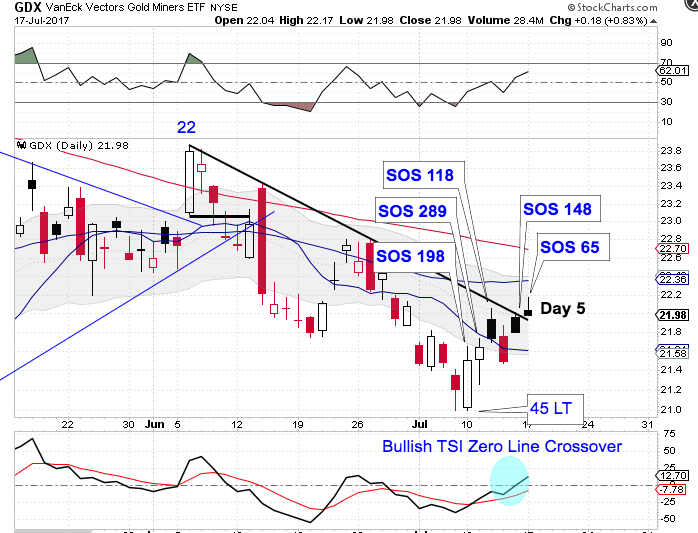The Miners broke above the declining trend line on Monday to confirm the new daily cycle.

I have received some emails asking if the Miners have also began a new intermediate cycle. There is no evidence on the daily chart to suggest that the Miners are in a new intermediate cycle. In fact, the Miners are currently in a daily downtrend, which is characterized by lows forming below the lower daily cycle band and highs forming below the upper daily cycle band. The Miners will need to close above the upper daily cycle band to signal a new intermediate cycle.
So while there is no evidence pointing to the Miners being in a new intermediate cycle, there is a weekly swing low that has formed which does open the possibility that the intermediate low has printed.

The Miners formed a weekly swing low on Monday. Our weekly cycle count places the Miners on week 11, which is too early for an intermediate cycle low. Only a close above the declining 50 week MA would change that view.
The Selling on Strength numbers also support that the Miners are still seeking out their intermediate cycle low.

Monday was day 5 for the new Miner cycle. Four of the past five days were bullish for the Miners. However, four of the past five days saw the Miners print large Selling on Strength numbers. And these large SOS numbers are the type of numbers associated with an intermediate decline.
Note: All information on this page is subject to change. The use of this website constitutes acceptance of our user agreement. Please read our privacy policy and legal disclaimer. Opinions expressed at FXstreet.com are those of the individual authors and do not necessarily represent the opinion of FXstreet.com or its management. Risk Disclosure: Trading foreign exchange on margin carries a high level of risk, and may not be suitable for all investors. The high degree of leverage can work against you as well as for you. Before deciding to invest in foreign exchange you should carefully consider your investment objectives, level of experience, and risk appetite. The possibility exists that you could sustain a loss of some or all of your initial investment and therefore you should not invest money that you cannot afford to lose. You should be aware of all the risks associated with foreign exchange trading, and seek advice from an independent financial advisor if you have any doubts.
Recommended Content
Editors’ Picks
AUD/USD rises to two-day high ahead of Aussie CPI

The Aussie Dollar recorded back-to-back positive days against the US Dollar and climbed more than 0.59% on Tuesday, as the US April S&P PMIs were weaker than expected. That spurred speculations that the Federal Reserve could put rate cuts back on the table. The AUD/USD trades at 0.6488 as Wednesday’s Asian session begins.
EUR/USD holds above 1.0700 on weaker US Dollar, upbeat Eurozone PMI

EUR/USD holds above the 1.0700 psychological barrier during the early Asian session on Wednesday. The weaker-than-expected US PMI data for April drags the Greenback lower and creates a tailwind for the pair.
Gold price cautious despite weaker US Dollar and falling US yields

Gold retreats modestly after failing to sustain gains despite fall in US Treasury yields, weaker US Dollar. XAU/USD struggles to capitalize following release of weaker-than-expected S&P Global PMIs, fueling speculation about potential Fed rate cuts.
Ethereum ETF issuers not giving up fight, expert says as Grayscale files S3 prospectus

Ethereum exchange-traded funds theme gained steam after the landmark approval of multiple BTC ETFs in January. However, the campaign for approval of this investment alternative continues, with evidence of ongoing back and forth between prospective issuers and the US SEC.
US versus the Eurozone: Inflation divergence causes monetary desynchronization

Historically there is a very close correlation between changes in US Treasury yields and German Bund yields. This is relevant at the current juncture, considering that the recent hawkish twist in the tone of the Fed might continue to push US long-term interest rates higher and put upward pressure on bond yields in the Eurozone.